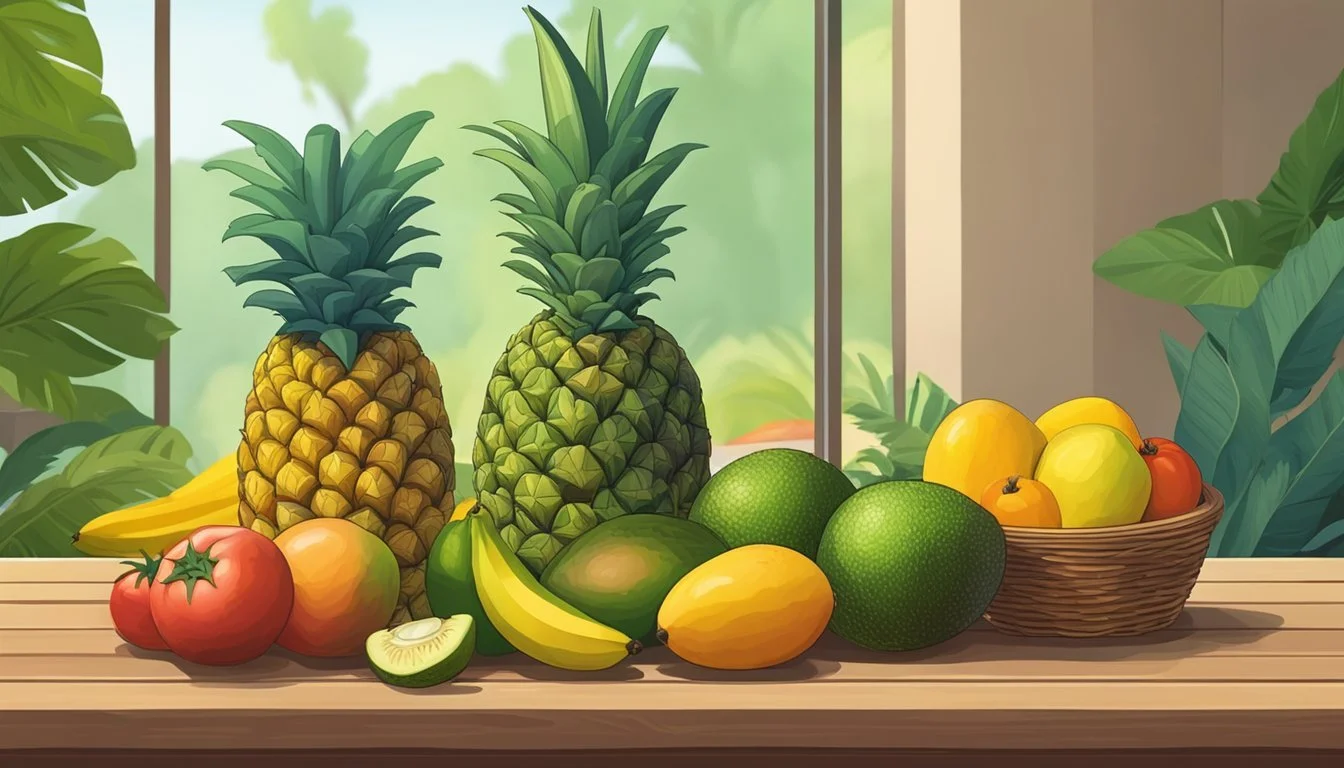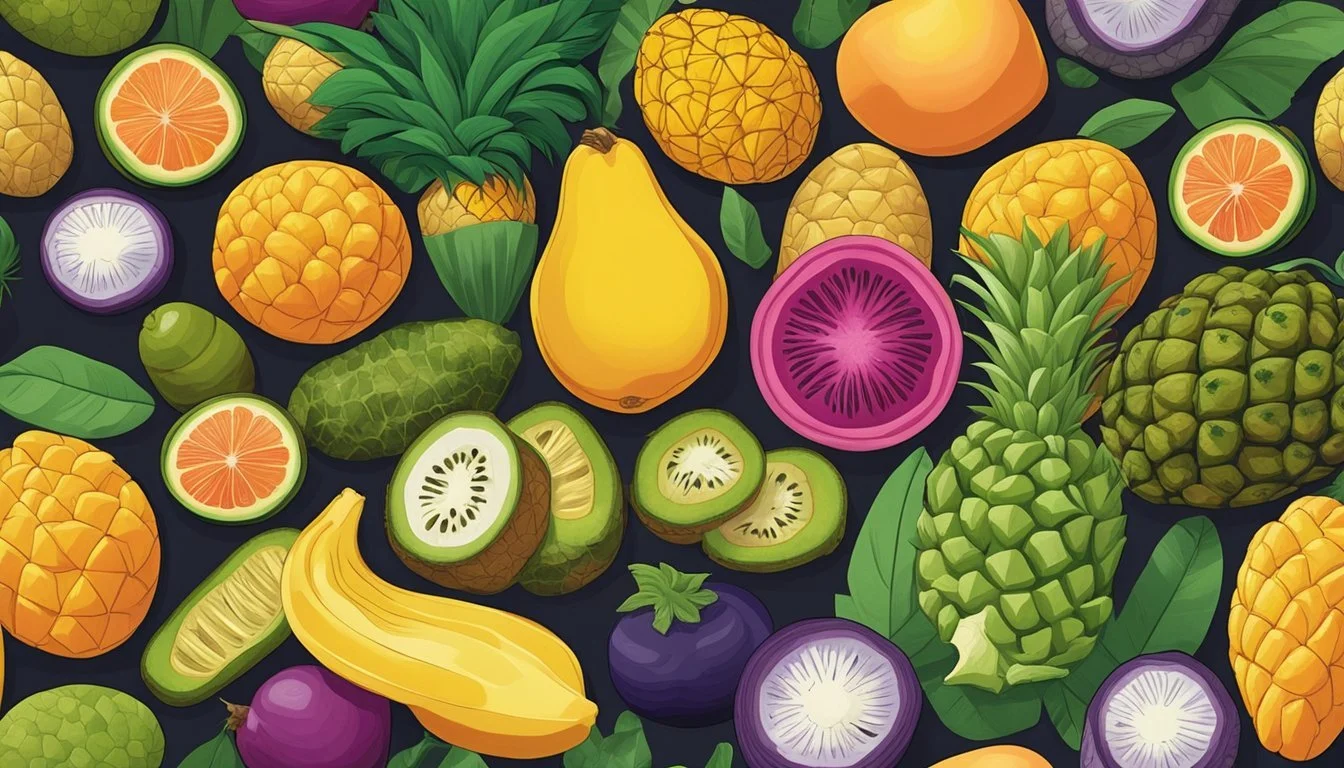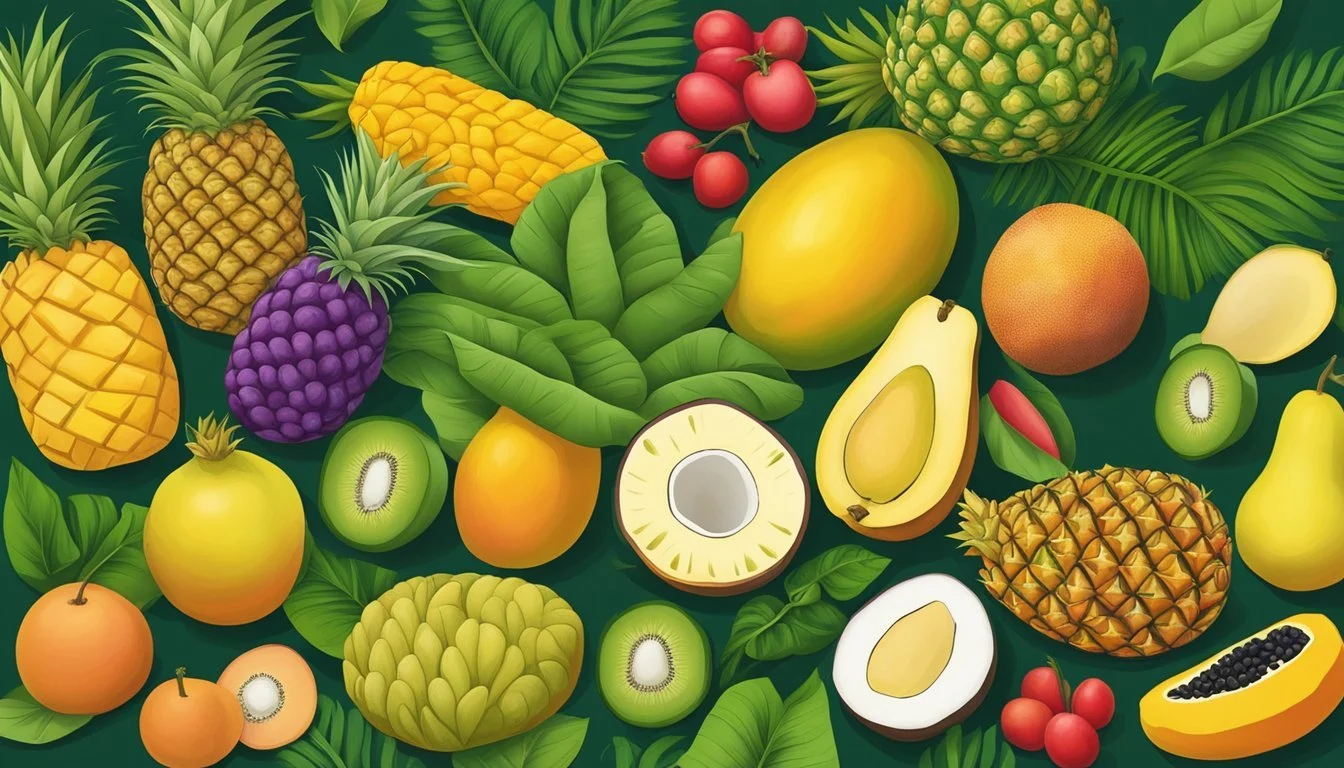Hawaii Seasonal Fruit & Vegetables in September
A Guide to Fresh Produce
This Article is Part of our Hawaii Seasonal Fruit & Veg Calendar
Hawaii's diverse climate creates an environment where a variety of fruits and vegetables can flourish throughout the year. September in Hawaii is particularly rich in produce, offering a range of delicious options for both locals and visitors alike. The islands' fertile soil and favorable weather conditions contribute to the growth of both tropical fruits and nutritious vegetables that are prime for harvest during this time.
Among the available produce, fruit lovers will find September a delightful month to indulge in Hawaii's offerings. Starfruit, with its unique shape and refreshing flavor, is in ample supply. Rambutan, too, known for its hairy exterior and juicy, sweet taste, is another tropical treat to enjoy. Consistent with Hawaii's year-round growing season, the ever-popular pineapple continues to be a staple fruit during this month.
In terms of vegetables, the selection is just as enticing, with many staples reaching peak maturity. The produce harvested during September boasts not only flavor but also nutritional value, embodying the vibrant and healthful essence of Hawaiian agriculture. For those exploring the farmers' markets or local produce stands, it's an excellent time to experience the true taste of the islands' bountiful harvest.
Overview of Hawaii's Seasonal Produce
Hawaii's unique tropical climate gifts its agriculture with a dynamic variety of seasonal fruits and vegetables. The combination of rich volcanic soil, year-round warm temperatures, and distinct microclimates across the islands supports a September harvest that is both bountiful and diverse.
Climate Influence on Harvest
Hawaii's tropical climate plays a pivotal role in shaping the harvesting timeline for its produce. The islands' consistent temperatures and rainfall patterns create an environment that allows for a steady growth of crops. In September, the climate contributes to the harvesting of several fruit and vegetable varieties, which rely on the month's specific conditions for optimal ripeness and yield.
Harvesting Timeline
In September, Hawaii's harvest includes a range of fruits and vegetables. Among them are:
Fruits:
Avocados - Different varieties including Mexican, Guatemalan, and hybrids.
Bananas (how long do bananas last?) - Though available year-round, they peak from June to October.
Passion Fruit - Widely known in Hawaii as Lilikoi, September is within its peak season.
Vegetables:
Corn - Available fresh from the fields.
Cucumbers - Harvested during this month.
Lettuce - Fresh and crisp in the late summer warmth.
Certain crops such as eggplant and green beans can also be found fresh in September.
Importance of Local Fruit and Vegetable Consumption
The consumption of local fruit and vegetables in Hawaii is crucial for several reasons. Consuming local produce ensures freshness and supports Hawaii's economy by boosting local agriculture. Additionally, it reduces the carbon footprint associated with transporting imported goods. Eating locally harvested fruits and vegetables also allows residents and visitors to enjoy produce at its peak flavor and nutritional value.
Fruits Available in September
In September, Hawaii offers a bountiful range of fruits, with options spanning from exotic tropical varieties to familiar berries and refreshing citrus. The warm climate allows for a year-round growing season, providing an abundance of fresh choices.
Exotic and Tropical Fruits
Hawaii's warm September weather nurtures a variety of exotic and tropical fruits that are at their peak.
Papayas: These are plentiful and can be enjoyed fresh or used in smoothies and salads.
Mangoes: With their rich, sweet flavor, mangoes are a Hawaiian favorite that are typically harvested through September.
Coconut: Available year-round, coconuts in September can provide a refreshing drink or be used in desserts and cooking.
Lychee: This small, sweet fruit is often enjoyed fresh and is typically available in Hawaii during the early part of September.
Rambutan: Similar to lychee, rambutan has a sweet and slightly acidic taste, encased in a hairy shell.
Starfruit: Known for its star-shaped cross-section, starfruit offers a juicy and crisp texture.
Lilikoi (Passion Fruit): The tangy, aromatic fruits are widely used in Hawaiian cuisine for their juice and pulp.
Berries and Melons
While not as commonly associated with Hawaii as tropical fruits, berries and melons still play a part in September's harvest.
Strawberry Guava: This is a small, red fruit that offers a sweet and slightly tart flavor, which makes it perfect for jams and jellies.
Citrus Varieties
Hawaii's citrus season begins to peak as fall approaches, and September sees a fresh supply of citrus varieties, including:
Guava: In Hawaii, guava is a popular fruit that can be eaten fresh or processed into juices, jellies, and pastries. Its unique flavor is both sweet and tangy.
Despite not being a traditional citrus fruit, guava holds a citrus-like position in many Hawaiian dishes and beverages due to its bright and acidic flavor profile.
Vegetables Peaking in September
In September, a diverse range of vegetables thrive in Hawaii's fertile soils, offering an abundance of fresh options for culinary use. From leafy greens to hearty tubers, the vegetables peaking during this month are distinguished by their freshness and flavor.
Leafy Greens and Salad Vegetables
In Hawaii, September sees a variety of leafy greens and salad vegetables at their peak. Farmers' markets are vibrant with:
Cabbage: Particularly fresh and tender at this time, ideal for salads or slaws.
Celery: Crispy with a satisfying crunch, providing a refreshing bite to dishes.
Roots and Tubers
Root vegetables and tubers thrive in the September climate, becoming staples on the dinner table. Key varieties include:
Carrots: Their sweetness is enhanced when harvested in the cooler September weather.
Sweet Potatoes: Known for their rich, creamy texture and versatility in both savory and sweet dishes.
Radish: Adds a peppery kick to salads, perfect for adding depth to autumn dishes.
Ginger: Harvested for its pungent and spicy flavor, elevating any dish it accompanies.
Taro: An integral part of Hawaiian cuisine, often used to make the traditional dish 'poi'.
Squash and Gourds
A wonderful selection of squash and gourds are ready for harvest, with varieties like:
Squash: Comes in several varieties, each with their unique texture and flavor.
Zucchini: Not only is it abundant, but it's also incredibly versatile, great for grilling, sautéing, or baking.
These vegetables represent a fraction of Hawaii's bountiful September produce, offering flavors that are as rich and diverse as the islands themselves.
Choosing and Using Hawaiian Produce
When selecting Hawaiian produce in September, one should be aware of seasonal availability and how to maximize freshness and flavor. It's important to remember that local fruits and vegetables can offer superior taste compared to their imported counterparts.
Selecting the Best Produce
Selecting the best Hawaiian fruits and vegetables at the peak of their season ensures the most flavorful experience. In September, one should look for:
Starfruit: Choose fruits with a bright yellow skin and a slight give.
Rambutan: Look for vibrant color and firmness.
Vegetables: Various vegetables are also available and should appear fresh without any wilting or yellowing leaves.
When shopping, consider visiting local farmers markets to find the freshest seasonal produce. Vendors at these markets often have a deep knowledge of their produce and can provide insights into the best picks.
Preparation and Recipes
Once the freshest produce has been selected, preparing and incorporating them into recipes can enhance any meal with a taste of Hawaii. Starfruit can be sliced and added to salads or served as a garnish. Rambutan can be peeled and eaten fresh or used in tropical fruit salads. Here are some ideas:
Healthy salads with thinly-sliced starfruit and a citrus vinaigrette
Tropical smoothies with a blend of local fruit for a refreshing treat
Considering the diverse range of vegetables available, one can also experiment with various cooking methods, such as roasting or sautéing, to bring out natural flavors.
Preservation and Storage
Proper preservation and storage of Hawaiian produce is essential to maintain freshness. For most fruits, storing them in a cool, dry place away from direct sunlight is best. For specific items:
Starfruit is best kept at room temperature until ripe, then can be refrigerated.
Rambutan should be stored in a perforated bag in the refrigerator to extend freshness.
For vegetables, cool and darker places like refrigerators typically prolong their lifespan, especially when kept in the crisper drawer. Washing just before use rather than before storage can prevent premature spoilage.
Purchasing Hawaiian produce during the right season and storing it correctly can greatly enhance one's cooking and eating experience. Whether it's through preparing vibrant recipes or enjoying the taste of fresh local fruit, the flavors of Hawaii are a bountiful addition to any kitchen.
Seasonal Eating and Nutrition
Eating seasonally benefits one's nutrition as fruits and vegetables are at their peak in both flavor and nutritive value. In Hawaii, September offers a wealth of produce that aligns with these principles. This month, they can indulge in fruits like the apple banana, which is known for its sweet taste and hints of apples and strawberries, proving to be both delicious and healthy.
A variety of vegetables are also tender and rich in nutrients. One could include them in their diet to take advantage of their fresh, juicy quality and full-bodied flavor, which processed or out-of-season produce typically lacks.
Here's a snapshot of what to expect in September:
Fruits:
Bananas (Apple Banana specifically): Sweeter and shorter than the common Cavendish, they offer a delicious blend of flavors.
Pineapples: They are at their sweet and tart best, providing an excellent source of vitamin C.
Vegetables:
Luau leaf (taro leaf): Represents a nutritious leafy green, an excellent ingredient for traditional dishes.
These options, along with other available local produce, not only provide a delicious dining experience but also contribute to a well-rounded healthy diet. Locals and visitors alike are encouraged to explore the rich tastes and nutritional benefits of the islands' seasonal offerings.
Cultural Significance of Seasonal Produce
In Hawaii, the intertwining of seasonal produce with cultural practices is a testament to the island's rich heritage. Fruits and vegetables not only nourish the body but also carry ancestral significance and are central to communal celebrations.
Traditional Hawaiian Foods
The Hawaiian diet traditionally incorporates a wide variety of fruits and vegetables that align with the seasons. Key staples include 'ulu (breadfruit), which is cherished for its versatility and cultural importance. It serves not just as food but also symbolizes growth and connection within the community. Celebrations like luaus often feature 'ulu along with other native crops such as sweet potatoes and taro (kalo), which is the source of poi—a traditional Hawaiian staple with deep cultural roots.
Traditional Food Cultural Significance 'Ulu (Breadfruit) Represents growth and communal connection. Often used in Hawaiian cuisine. Taro (Kalo) The source of poi, a sacred element of the native Hawaiian diet, embodying deep connections to the land (‘āina). Sweet Potato Commonly grown and enjoyed in a variety of dishes, reflecting the adaptability of Hawaiian agriculture.
Festivals and Celebrations
Hawaiian festivals and celebrations heavily feature seasonal fruits which are ingrained in the cultural fabric of Hawaii. For example, the Hawaii Maoli mango festival, where locals and visitors alike celebrate the mango, highlights just how much this fruit is woven into the island's culture. Mango salsa, açaí bowls, and breads are just a few ways this fruit is celebrated, spotlighting Hawaii's diverse culinary influences. Such festivals also serve to solidify community bonds and educate on the importance of sustainable, local agriculture.
Festival Celebrated Produce Cultural Role Mango Festival Mangoes Serves as a platform for celebrating the diversity and versatility of the mango, showcasing traditional and modern culinary practices. Luaus Variety of Seasonal Fruits and Vegetables A gathering place that honors Hawaiian history and the bounty of the land through food and fellowship.
Seasonal fruits and vegetables in Hawaii are more than just sources of nourishment; they are conduits of culture and tradition, making their way from the land to the heart of societal celebrations.
Agricultural Practices and Sustainability
In Hawaii, a commitment to sustainable agricultural practices is essential due to the islands' unique climate and ecosystems. Farmers across the state employ eco-friendly techniques to ensure that their farms contribute positively to both the environment and the community.
Sustainable Farming Practices:
Use of organic methods to enrich soil and control pests
Implementation of crop rotation and polyculture to maintain soil health
Rain harvesting systems to utilize the tropical climate efficiently
Hawaiian agriculture benefits from a warm climate and ample rain, creating a conducive environment for growing a wide variety of produce year-round. However, the reliance on agriculture also makes sustainability crucial. Farmers are increasingly moving towards methods that minimize their environmental impact.
Hawaii's Eco-Friendly Initiatives:
Water conservation efforts to mitigate wastage
Renewable energy utilization to power operations on the farm
Education programs to teach sustainable methods and organic farming
With overreliance on imports, local farmers are pivotal in moving towards a more self-sustained way of life. Organizations like the Hawaii Organic Farming Association play a supportive role by promoting sustainable lifestyle practices.
Climate Adaptive Farming:
Selection of crop varieties that withstand Hawaii's diverse microclimates
Farming techniques adaptive to changes in rainfall patterns
These initiatives highlight the essential relationship between the climate and agricultural practices in Hawaii. They underscore the role that sustainable, responsible farming practices play in preserving the island's natural beauty and resources, ensuring that the land thrives for future generations.
Impact of Tourism on Seasonal Produce
Tourism significantly influences Hawaii's agricultural landscape, particularly in the consumption and distribution of seasonal produce. As visitors flock to the islands, demand for local fruits and vegetables surges. This increased demand can lead to a more robust local market, encouraging grocery stores and restaurants to stock Hawaii-grown items.
Produce Consumption:
Tourists often seek authentic experiences, including tasting local cuisine.
Items like avocados, which are in season from September through April, may see heightened demand.
Economic Impact:
The tourism sector supports agriculture indirectly by promoting sales of local produce.
Agricultural producers may shift their focus to crops favored by tourists, influencing the types and quantities of produce grown.
Grocery Store Trends:
Stores may allocate more shelf space for products that appeal to tourists.
Locally grown, seasonal items can be advertised prominently to attract those seeking the Hawaiian experience.
Challenges:
There can be tension between meeting local needs and tourist demands.
Tourism spikes can pressure agricultural resources, sometimes at the expense of sustainability.
Tourism's economic ripple effects extend to the agricultural sector, embedding it as a crucial component of the islands' overall economy. The consumption patterns of tourists and the consequent procurement strategies of grocery stores play a role in shaping the agricultural production of Hawaii, especially during peak season.









